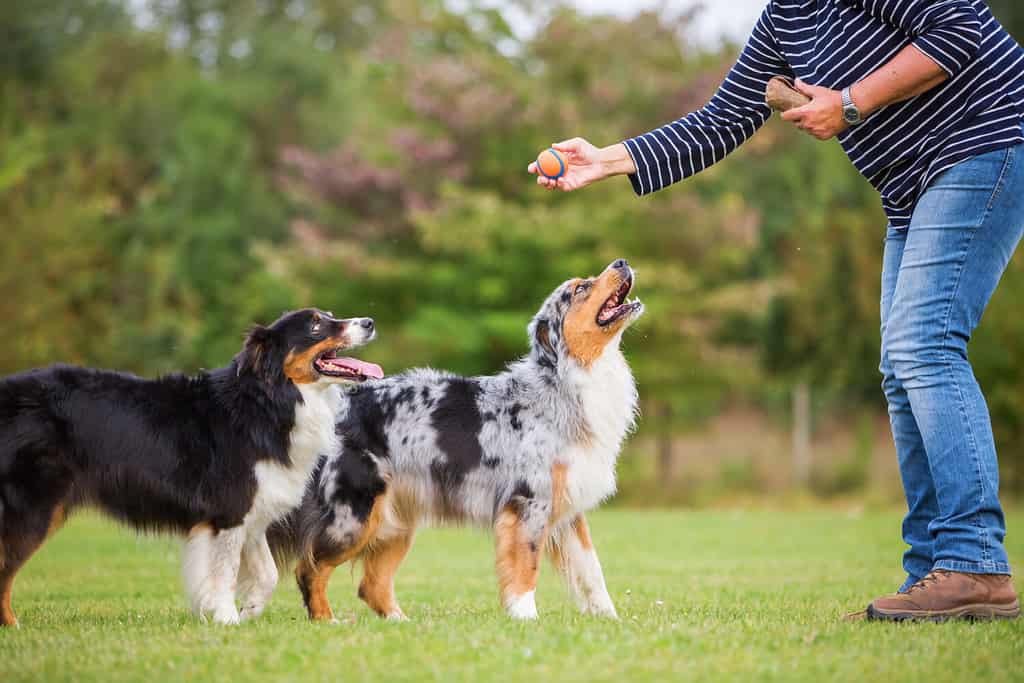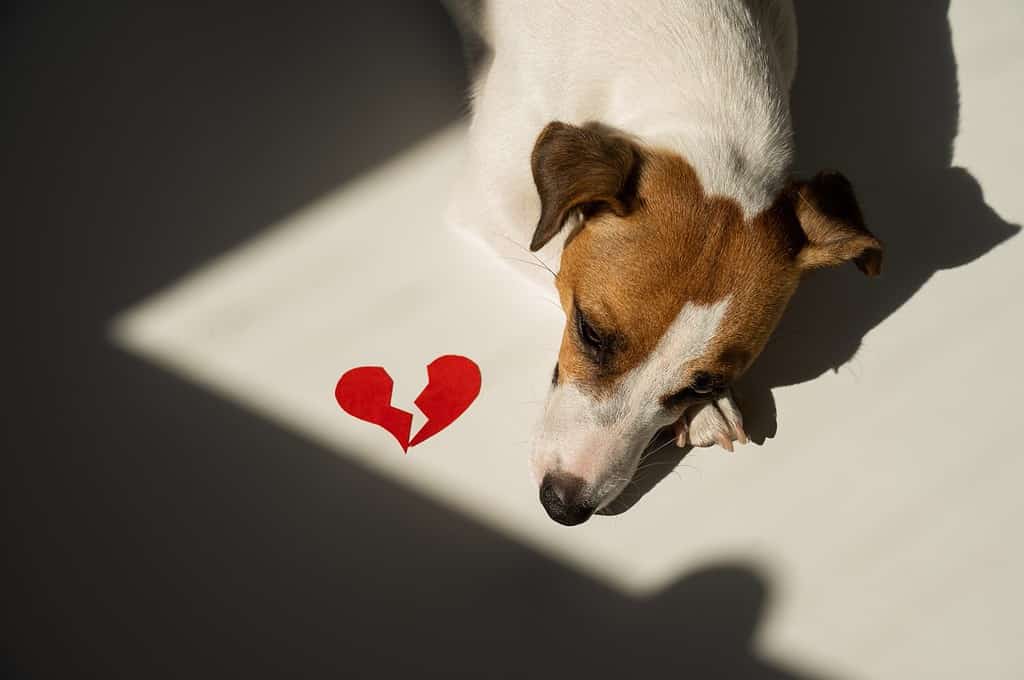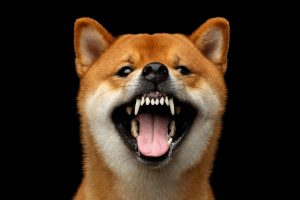Sit. Stay. Down. Most dog owners attempt to train their dogs to follow these basic commands. However, some dogs are more difficult to train than others due to temperament or individual personalities. What should you do when training sessions don’t go the way you — or your dog — would like?
Training your dog requires patience and persistence. It may be frustrating at times for both you and your dog. Though using a shock collar may seem like a viable way to expedite the training, we’ve listed 27 reasons to avoid using them with your dog.
1. There Is No Scientific Evidence They Work

Most professionals agree shock collars don’t work in the long run.
©Ekahardiwito/Shutterstock.com
Research conducted at the University of London involved a group of dogs wearing E-collars, or shock collars, and control groups using positive reinforcement methods. The results showed that the positive reinforcement forms of dog training have a higher efficacy than shock collar training.
Similar research has been done in universities in other countries, including New Zealand, the United States, and several European countries. In fact, several countries such as Canada, Norway, Sweden, Austria, Slovenia, and Switzerland have banned their use altogether.
2. It Takes More Time to Train

Shock collar training is not a quick fix.
©Romvy/Shutterstock.com
Erica Feurbacher who is a professor of Companion Animal Welfare and Behavior at Virginia Tech pointed out that the former study showed that those dogs trained with shock collars took more time to learn the basic sit command. In fact, their compliance slowed down more and more as the training proceeded.
3. Shock Collar Training Can Make Behavioral Problems Worse

Shock collar training can increase the very problems you are trying to mitigate.
©Sheryl Lynch/Shutterstock.com
The American Veterinary Society of Animal Behavior has stated that extensive research clearly shows that shock collar training is not conducive to stopping negative behaviors. Additionally, rather than seeing decreased behavior problems with increased use of shock collar training, we see the opposite. There is an increase in behavior problems in dogs the more that shock collars are used in training.
4. It Does Not Change Behaviors Long Term

Though you may see short-term results, there are no long-term benefits to shock collar training.
©Christian Mueller/Shutterstock.com
Shock collars may seem like a good solution, especially if you notice your dog immediately stopping the behaviors as soon as they’re shocked. However, they don’t really understand that the behavior is bad. Instead, they’re actually learning that if they do it, they’ll get shocked. Since the collar doesn’t help your pet understand what they should be doing instead, the behavior will likely continue once you take the collar off. In the long term, the dog doesn’t learn the way they should behave.
5. It Can Reinforce Negative Behaviors

Shock collar training can have a reverse effect on unwanted behaviors.
©Masarik/Shutterstock.com
Studies have shown that dogs trained with shock collars often have a higher frequency of the very behaviors their owners are trying to eliminate. This is largely due to the dog’s inability to distinguish what behavior is causing the pain from the shock. For example, if a shock is applied to a dog when they run out of the yard, they may run even more to try to escape the pain or discomfort.
6. It Lowers the Level of Engagement in Other Activities

Dogs who are trained with shock collars may lose interest in activities that used to engage them.
©NayaDadara/Shutterstock.com
Dogs who are subjected to shock collar training may become depressed. They may also lose interest in playing with their toys, spending time with other dogs, and even spending time with their owners. Shock collar training can change a dog both behaviorally and emotionally.
7. It Can Cause Emotional Pain for Dogs

Being shocked can be a traumatic experience.
©Zontica/Shutterstock.com
Shock collars deliver a jolt of pain. When shocked over and over again, dogs become fearful. They begin to feel helpless in not being able to escape the pain. This trauma can eventually lead to deep emotional pain in dogs.
8. It Can Increase Aggressive Behavior

Studies have proven that experiencing pain can lead to aggressive behavior.
©iStock.com/Milan Krasula
Using a shock collar to stop aggressive behavior in dogs generally worsens the aggression. Even if the shock collar training is being used to stop a behavior other than aggression in dogs, a long-term side effect may still be increased aggression. The physical and psychological effects of the pain inflicted on the dog create a fight-or-flight response. In the case of a dog’s response to shock collar training, that’s usually fight, or aggression.
9. It Can Disrupt the Dog’s Relationship with Their Owner

The bonds between dogs and their owners are special.
©Branislav Nenin/Shutterstock.com
Dogs depend on their owners for everything. Whether it’s having their basic needs met, receiving mental stimulation, or feeling safe and loved, they look to their owners to provide it for them. But what happens when the very people they depend on inflict discomfort or pain on them?
Dogs don’t understand the principles behind shock collar training. All they know is that their owners are hurting them. This, in turn, breaks down the trust that has been previously built between them.
10. Shock Collars Can Malfunction

Like any other electrical device, shock collars have been known to malfunction.
©Parilov/Shutterstock.com
Shock collars, even “high-quality” ones, can malfunction. Many dogs have received severe burns from wearing a defective shock collar. In some cases, dogs’ collars ended up shocking them ceaselessly for hours before owners discovered the problem.
Some shock collars have been reported to go off by themselves. That can actually end up correcting a dog’s positive behavior if it goes off at the wrong time. Also, since these collars are placed around dogs’ throats, any malfunction could be serious or even life-threatening.
11. It Hurts

Most pet owners love their fur babies and wouldn’t intentionally hurt them.
©Reshetnikov_art/Shutterstock.com
A common myth for the advocacy of shock collars is that they don’t hurt dogs. Some people even go so far as to test the collars on themselves. They think that, if the collar doesn’t them, it can’t hurt their dog.
First of all, people experience pain differently than dogs, making the comparison moot. Secondly, most shock collars use jolts of two volts or currents of about 30 to 80 milliamps, which can cause injury or death. Of course, this can vary from collar to collar. Nevertheless, just 10 milliamps of current can produce a severely painful shock.
12. It Can Have Negative Neurological Effects

It’s difficult to predict how even the smallest current of electricity will affect a dog.
©Jessica Loijens/iStock via Getty Images
Shock collars work by delivering an electrical shock directly to your dog’s muscles via metal prongs attached to the collar. The goal is to cause the dog’s muscles to contract, startling them and thereby distracting them from the bad behavior. However, these shocks can cause nerve damage. Since it doesn’t take much current to cause serious issues, regulating the proper current is difficult, if not impossible.
13. It Can Cause Cardiovascular Issues

Dogs can develop heart problems from repeated shocks.
©In Green/Shutterstock.com
The electrostatic shock from shock collars can lead to an increase in heart rate in dogs. As the dog experiences repeated shocks, its heart is put under stress. As a result of this stress, the dog’s heart and cardiac muscles can become strained, leading to a malfunctioning heart.
14. It Can Cause Burns

Shock collars can cause mild skin irritations (see photo) to severe burns.
©ThamKC/Shutterstock.com
A typical shock collar has metal prongs that touch a dog’s skin. When the volts of electricity pass through the prongs, they can cause minor irritations and discomfort to the skin. However, it’s not uncommon for dogs to suffer severe burns that lead to open wounds that may require first aid. Not only can the burns be severe and painful, but they can emotionally scar the dog as well.
15. It Can Be Misused

Even the best-intentioned pet owners can misuse shock collars.
©MrKawa/Shutterstock.com
Shock collars are often misused even by self-acclaimed professional dog trainers. Pet owners are most often not professional trainers, so the chance of misusing these collars is even greater. For instance, timing becomes very important with these collars. If the shock isn’t given at precisely the right moment, the dog can become confused, associating the shock with the wrong behavior.
16. It Is a Form of Punishment

When owners punish their dogs, it can make them fear their owners.
©PPstudio/Shutterstock.com
There are two kinds of punishment — negative and positive. Negative punishment occurs when you withhold something your dog enjoys, such as a treat, when they’re displaying negative behavior. Positive punishment occurs when you give your dog something they don’t like, such as a shock.
Positive, in this sense, doesn’t mean beneficial. Rather, it means giving something averse instead of taking away something desired. Studies have shown that reward-based training is more effective than punishment, or aversion training.
17. It Is Not Humane

All animals are entitled to freedom from discomfort.
©GoodFocused/Shutterstock.com
Any type of treatment which can be considered physically or psychologically damaging to a dog is inhumane. According to the Animal Humane Society, all animals are entitled to five freedoms, two of which are freedom from discomfort and freedom from pain. Using a shock collar violates the two mentioned freedoms.
18. Its Use Can Create a Fearful Dog

A dog’s brain can’t process information for learning when they’re afraid.
©Hanna Taniukevich/Shutterstock.com
Dogs feel stressed and fearful when they have no control over a situation. With shock collar training, they have no control over when the shock is administered. Therefore, they may freeze (as in “fight-flight-or-freeze”) when they feel the shock. Pet owners may misinterpret this as compliance when it’s really a fear response. Brain studies show that, just as in humans, dogs can’t learn when they are stuck in freeze mode.
19. There Is No Positive Reward

Dogs work best with positive reinforcement.
©ubaru/Shutterstock.com
Dogs learn best when there is a reward at the end of the session. However, the reward doesn’t necessarily have to be a treat. Knowing what your dog loves, such as playing with a particular toy, getting to go on a sniffing walk, or receiving praise, gives them the incentive to learn and obey.
Shock collar training works by inflicting punishment without offering a reward to provide an incentive. In essence, dogs may learn what not to do, but they don’t learn what to do instead. Using a reward system makes the dog more likely to repeat the desired behavior.
20. It Can Cause Seizures

Receiving jolts of electricity can cause neurological damage or even induce seizures.
©Olya Maximenko/Shutterstock.com
It is possible to deliver enough electrical stimulation via the shock collar to cause a dog’s blood pressure to increase. That rise in blood pressure could lead to eye or brain damage. It could also cause a dog to have seizures, in which their muscles stiffen and twitch. The dog could even lose consciousness.
21. It Increases a Dog’s Production of Cortisol

When stressed, dogs release a stress hormone called cortisol.
©Sopon charoensuk/Shutterstock.com
There have been several studies on beagles and the effects of shock collar training. The research has shown that the inability of the dogs to predict and control the delivery of shocks from the collar causes a stress response and a rise in the stress hormone we call cortisol. If a dog is exposed to long-term or severe stress, it can change their whole personality. The dog may become fearful, passive, or helpless.
22. What About Bark Collars?

Dogs bark to communicate. It’s a natural instinct.
©Annette Shaff/Shutterstock.com
There are many types of bark collars on the market. However, these collars use electrical shocks as well. In addition, their purpose is to stop a dog from expressing its natural behavior. Dogs bark for a reason, whether it’s to warn or send another message. It’s confusing to dogs when they experience pain every time they do something that’s instinctive to them.
23. What About Invisible Fence Collars?

Chain-link fencing and regular collars are a more humane form of containment.
©Wendy van Overstreet/Shutterstock.com
These shock collars work with invisible fencing systems to, ideally, contain your dog in an area. Unfortunately, they work by inflicting pain as other shock collars do. One of the problems, aside from the punishment for the dog, is that other animals can still enter the yard or contained area. The system can also malfunction, allowing the dog to escape. Wearing the collar can even prevent your dog from reentering the yard if it sends shocks at that point.
24. Shock Collars Are Banned in Other Countries

Many countries have labeled shock collars as cruel and inhumane.
©Victor Maschek/Shutterstock.com
Many countries have done extensive research and found that the physical and psychological damage done to dogs while wearing shock collars is unwarranted. They’ve found that not only are these devices detrimental to dogs’ welfare, but they’re less effective than positive reinforcement training.
Countries that have banned shock collars include
- England
- Scotland
- Norway
- Sweden
- Denmark
- Switzerland
- Austria
- Germany
- Canada
- Slovenia
- Many parts of Australia
- In the U.S., Boulder, CO, has banned shock collars.
25. It Has Been Known to Cause Death in Dogs

The use of shock collars can cause fatal injuries.
©Javier Brosch/Shutterstock.com
One of the most significant reasons to avoid shock collars is that there have been cases of death from the trauma of shock collar injury. In one such case in San Francisco in 2022, Jason Stock’s dog, Bubba, was being trained by a professional trainer who used an e-collar (shock collar). After being zapped during a training session, Bubba was found motionless in a puddle of his own vomit and feces. He died the next day.
26. Because You Love Your Dog

Most pet owners want the best for their fur babies.
©iStock.com/Aleksandr Zotov
Pet owners love their fur babies. Most pet owners want their dogs to be happy and healthy. Knowing that there are other ways to train your dog without physical or psychological pain is reassuring. Just as most parents would never dream of sending volts of electricity through a collar to train their children, neither should pet parents use this with their furry children.
27. There Are Better Methods to Train Your Dog

Some animal trainers use whistles as an additional tool for teaching dog obedience.
©iStock.com/Peter-verreussel
There are several other discipline methods that owners can use to teach their dogs in a safe and healthy learning environment. Just like humans, when dogs feel safe, they learn better. Read on to find five alternative ways to positively train your dog.
| Training Method | Methodology |
|---|---|
| Positive Reinforcement | When the dog performs the desired behavior, it’s immediately followed up with a reward. |
| Science-Based | This training requires the owner or trainer to develop a relationship with their dog. By learning the dog’s body language and reward preferences, the trainer uses it to let the dog’s responses drive the training. |
| Clicker or Whistle | Like positive reinforcement, when a dog performs a desired behavior, the owner makes a click or blows the whistle, which is quickly followed by a reward. |
| Mirror Training | The trainer uses another person or well-trained dog to model the desired behavior while the dog-in-training observes. The desired behavior is praised and rewarded. |
| Relationship-Based | This training requires the owner or trainer to develop a relationship with their dog. By learning the dog’s body language and reward preferences, the trainer uses it to let the dog’s responses drive the training. |
Ready to discover the top 10 cutest dog breeds in the entire world?
How about the fastest dogs, the largest dogs and those that are -- quite frankly -- just the kindest dogs on the planet? Each day, AZ Animals sends out lists just like this to our thousands of email subscribers. And the best part? It's FREE. Join today by entering your email below.
Thank you for reading! Have some feedback for us? Contact the AZ Animals editorial team.








